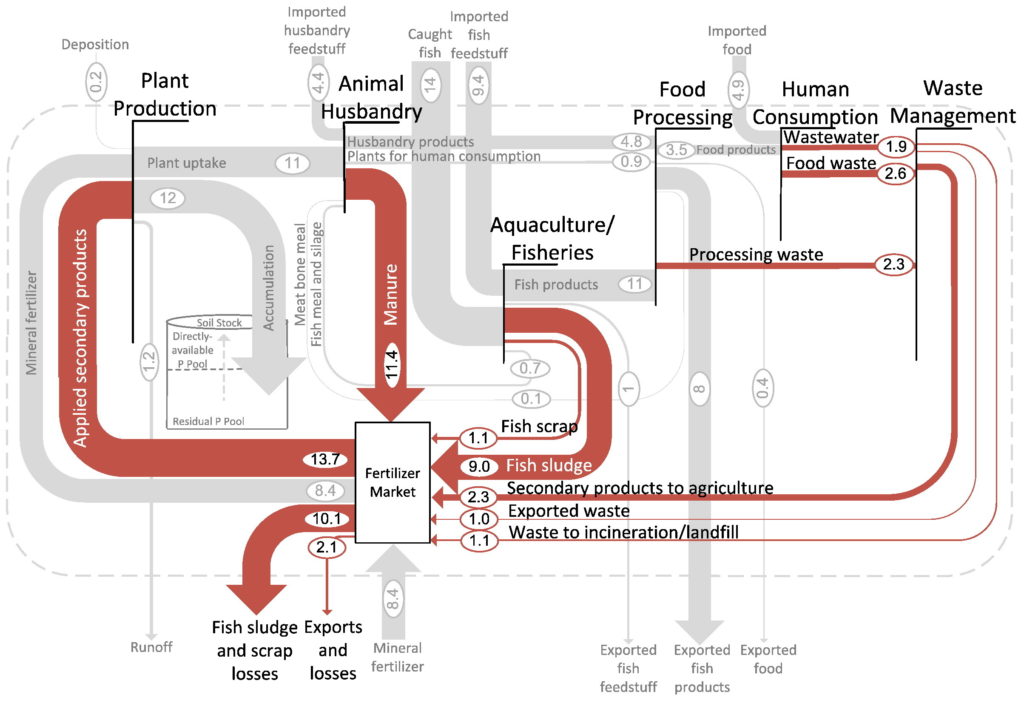Phosphorous is an essential component of life and an important macronutrient for food production. The current use of phosphorous is inefficient and unsustainable. What can we do to transform Phosphorous use ?
We are mapping the stocks-flows of phosphorous in a systems context to understand barriers and opportunities in transformation of phosphorous cycle. We are working closely with industry and public representatives to inspire action on the ground.
Why re-cycling phosphorus is important?
Phosphorous (P) is an un-substitutable element of life and an essential macronutrient for food production; making its access central for food security. Today, P is mostly obtained from mined phosphate (Pi) rock, it is a non-renewable resource on a human time scale; ongoing mining worldwide is depleting high quality phosphate rock.
The current use of P is inefficient and leaky, particularly in the agricultural sector, thereby causing eutrophication problems in natural bodies of water. Moreover, since Pi rock is generally contaminated with toxic heavy metals and radioactive elements, there is concern that they may cause health and environmental issues through the long-term application of chemical fertilizers to farmland. In this sense, the sustainable management of P is becoming an increasing global concern on food and environmental securities.
Importance in Norway
Norway is currently dependent on large amounts of mineral P fertilizers produced from phosphate rock imported mainly from Morocco, while accumulating unused P resources in soils and aquatic systems.
Norway imports more than 9kt per year of P in the form of mineral fertilizers, but has the potential to significantly reduce this dependence by recycling waste P flows, especially from agriculture and aquaculture. We have found out that the average amount of manure in Norway is 10.9 kt plant-available P per year. Theoretically, this source of secondary P from manure would be sufficient to cover the total national fertilisation demand, which was estimated at 10.5 kt P per year. We can see the importance of action towards bio-economy transition. Our research has shown that the P resources in by-products from agriculture (dominated by manure) and aquaculture (dominated by fish sludge) generated in Norway are more than four times as large as the P demand for fertilization, and that this secondary resource surplus may increase to a factor of 12 by 2050. If we learn to re-cycle and use P efficiently, the national demand P could be as low as 5.8 kt plant-available P, at which point the supply from manure could be more than enough to make Norway independent from mineral fertiliser imports in the short term1.

The different sectors in the Norwegian bio economy are becoming increasingly interdependent. By-products of agriculture, fisheries, and fish farming have cross-sectoral applications. Aquaculture increasingly depends on feed and feed ingredients from agriculture. Fish sludge has a large potential for applications as a fertilizer in agriculture or as nutrient provider for IMTA products such as seaweed, which in turn finds uses in human consumption or as feed. Isolated understanding of these sectors is insufficient in order to realize the potential for cross sectors synergies. A systems understanding of the interlinkages between the sectors and environment can help support the transition towards a circular bio-economy
In MIND-P we identify challenges and opportunities in bio economy transition using a systems approach. We map, quantify and visualize P flows through the system i.e., all sectors that produce, consume and waste P.

Our aim is to analyze pathways towards independence from mineral P fertilizer use through improved recycling with a focus on manure and fish sludge. We will achieve this by : (1) estimating the local secondary P supply potential (2) analyzing the key barriers and opportunities for utilizing this potential and (3) testing different strategies and technologies in model simulations and scenarios developed in close collaboration with key stakeholders.
In the project, we analyze the barriers and opportunities for transforming the Norwegian bio-economy to reach (direct) mineral phosphorus independence by 2030, focusing on manure and fish sludge. We include (i) the spatial distribution of secondary P generation and options to use them locally (e.g., IMTA) or to collect and transport them to places where they are needed (manure and fish sludge), (ii) quality issues related to plant availability, (iii) quality issues related to toxicity (e.g., sources of heavy metal concentration in fish sludge), (iv) economic barriers related to costs of alternative systems and technologies, and (v) concerns of producers and consumers related to the acceptance of alternative systems and products.
1 Hamiltion et al 2017., Recycling potential of secondary phosphorus resources as assessed by integrating substance flow analysis and plant-availability.
Helen A. Hamilton, Eva Brod, Ola Hanserud, Daniel B. Müller, Helge Brattebø and Trond K. Haraldsen
https://doi.org/10.1016/j.scitotenv.2016.10.056
